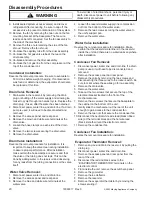
Component Testing
To avoid risk electrical shock, personal injury, or death,
always disconnect electrical power source to the freezer
before attempting to service, unless test procedures require
power to be connected. When removing any wiring from terminals they must be replaced on the same terminals.
Ensure all ground wires are connected before certifying unit as repaired and/or operational.
WARNING
!
12
16022217 Rev. 0
©2003 Maytag Appliances Company
Symptoms of this include thin or no ice slab (depending
on severity of leak) and, more noticeably, water draining
through to the drain during the ice production cycle (do
not mistake this for reservoir run off water or melted ice
drain water from the ice bin). The drain valve should be
replaced if it is found to be leaking.
The drain valve solenoid actuator can also possibly fail.
Test the solenoid by checking the resistance. A
resistance of 50-65 ohms should be found. If no
resistance is found, the drain valve will need to be
replaced.
Water Valve
The water valve supplies water to the reservoir for
producing ice. The valve opens for 1.0 minutes during
initial start-up of the unit and opens for 2.0 minutes in the
harvest cycle after the drain valve has closed.
The valve has a built-in screen in the water supply fitting.
This screen will filter out any large particles and, over
time, these particles will accumulate and restrict water
supply. If this is found, simply clean the screen with a
toothbrush to remove the particles.
DO NOT REMOVE
THE SCREEN FROM THE VALVE.
To check the water valve:
1. Check the solenoid actuator for resistance. If no
resistance is found, the valve will need to be
replaced.
2. Check to see if the valve will seat properly. Foreign
particles that may have passed the filter could
damage the seat of the valve. To make sure the valve
is seating, make sure power is disconnected to the
unit, hook up the water supply, turn on the water
supply, and see if there is any water flowing in the
water lines. If water is present and flowing, the valve
will need to be replaced.
3. Check the flow rate of the reservoir water line. Using
a stopwatch or a watch with a second hand, see what
amount of time it takes to fill up a one-quart
container. The time should be 60 seconds to get the
.25-gpm specifications of the valve.
If it takes substantially less than 60 seconds, check
the water supply pressure to make certain it is not
above 120-psi static pressure. If it is not, the metering
orifice of the valve has been changed and the valve
will need to be replaced.
If it takes substantially more than 60 seconds,
check the water supply pressure to maker certain it is not
below 20-psi static pressure. If it is not, make certain the
valve screen filter is clean. If the filter is clean, replace
the valve.
Condenser Fan
The condenser fan is used to force air over the
condenser coil. The fan will run only during ice
production cycle and turn off in ice harvest cycle.
To check the condenser fan:
Make sure motor shaft turns freely. This can be
done by rotating the fan blade by hand and
observing any excessive resistance.
Check for resistance between terminals. If no
resistance is found, replace the condenser fan.
Check for continuity between terminals and fan
casing. If continuity is found, replace the
condenser fan.
Check current draw. Typical current draw will be
.15 amp without fan resistance. If current draw is
.19 amp or more, check for resistance in air
movement or objects touching the fan blade. If
this is not found, then replace the condenser fan.
Thermistors
This unit utilizes two thermistors for reading
temperatures for input to the electronic control. Each
thermistor has a different function for input to the
electronic control.
Evaporator Thermistor
The evaporator thermistor is made up of a stainless steel
body and is secured to the under side of the evaporator.
The location of the thermistor allows the thermistor to
give voltage input to the electronic control. This input is
processed through the electronic control to switch the ice
maker into the production or the harvest cycles. The
thermistor must be tightly secured to the evaporator
bracket for proper heat transfer.
The following will happen in the event of a thermistor
failure:
1. If an evaporator thermistor fails, all loads will be shut
off and the unit will not run.













































